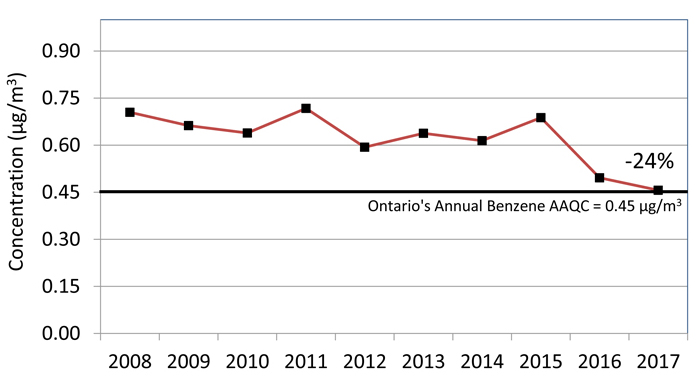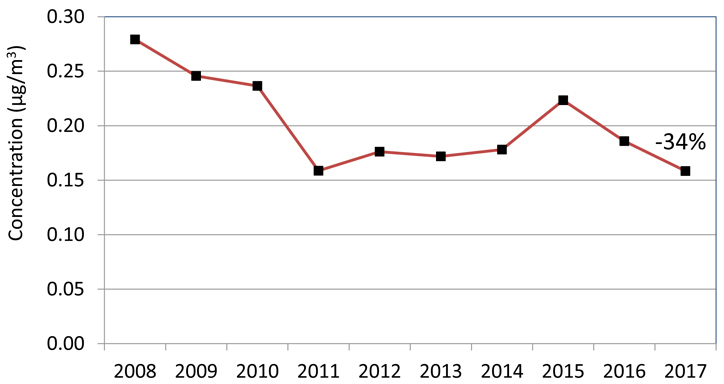Air toxics – select VOCs
Volatile organic compounds (VOCs) are organic chemical compounds that may evaporate under normal ambient conditions of temperature and pressure, such as benzene and toluene. VOCs are precursors of ground-level ozone and PM2.5. VOCs are emitted into the atmosphere from a variety of emission sources, including vehicles, fossil fuel combustion, steel-making, petroleum refining, fuel-refilling, industrial and residential solvent use, paint application, manufacturing of synthetic materials (e.g. plastics, carpets), food processing, agricultural activities and wood processing and burning. As stated in the Ground-level ozone section, general solvent use accounted for approximately 29% of total VOC emissions and the second largest source was the transportation sector accounting for approximately 28%. (Refer to Figure 8 for the estimates of Ontario’s VOCs emissions from point, area and transportation sources).
VOC monitoring
Specialized, non-routine monitoring and analytical techniques are required to measure VOCs because they are usually present in the atmosphere in a gaseous form at ultra-trace concentrations. VOCs are measured at seven AQHI air monitoring stations (Windsor West, Sarnia, London, Kitchener, Hamilton Downtown, Newmarket and Ottawa) by Environment and Climate Change Canada as part of a co-operative federal-provincial program under the NAPS Air Toxics Program. VOC samples are collected by automatically drawing ambient air into empty stainless-steel canisters over a 24-hour period (midnight to midnight), following the NAPS sampling schedule (typically every sixth day) for urban sites. In 2017, 107 VOCs were analyzed and reported for each sample at each site. For the purposes of this report, commonly detected VOCs (benzene, toluene, ethylbenzene, xylene, and 1,3-butadiene) between 2008 and 2017 are included in this discussion. Table 3 shows the AAQC for the VOCs studied here (where applicable). Annual 2017 statistics, as well as 10-year trends for the six select VOCs at each of the seven AQHI monitoring sites are presented in Tables A22-A33 of the Appendix.
| VOC | 24-hour AAQC | Annual AAQC |
|---|---|---|
| Benzene | 2.3 μg/m3 | 0.45 μg/m3 |
| Toluene | 2,000 μg/m3 |
n/a |
| Ethylbenzene | 1,000 μg/m3 | n/a |
| 1,3-Butadiene | n/a | 2.0 μg/m3 |
Benzene, toluene, ethylbenzene, xylene (BTEX)
Benzene is a VOC, which is primarily used in the production of plastics and other chemical products. Large quantities of benzene are produced from petroleum-related processes, either by direct extraction from certain types of crude oils or by chemical treatment of gasoline. Benzene is classified as a human carcinogen (USEPA, 2016).
In 2017, benzene annual means ranged from 0.34 µg/m3 at London to 0.60 µg/m3 in Sarnia. Ontario’s 24h AAQC for benzene of 2.3 µg/m3 was only exceeded at the Newmarket AQHI air monitoring station on one occasion. The 24-hour maximum benzene concentration reported at Newmarket was 2.5 µg/m3; in that sample, other VOCs (for example toluene) were also elevated indicating influence of local emissions and not necessarily representative of regional air quality.
Of the seven monitoring locations, the Ontario annual AAQC for benzene of 0.45 µg/m3 was exceeded at two AQHI air monitoring stations – Sarnia and Hamilton Downtown. The annual mean for benzene reported at Sarnia and Hamilton Downtown were 0.60 µg/m3 and 0.57 µg/m3, respectively. Over the 10-year period from 2008 to 2017, benzene concentrations in Ontario have decreased 24% as shown in Figure 23. Annual 2017 statistics, as well as 10-year trends, for benzene at each of the seven AQHI monitoring sites are presented in Appendix Tables A22 and A28, respectively.
Figure 23: Trend of benzene annual means across Ontario (2008-2017)

The benzene annual mean concentrations from 2008 to 2017 show a decreasing trend of 24% across Ontario.
Note: 10-year trend based on data from 7 ambient air monitoring stations.
Toluene is a VOC used to make chemicals, explosives, dyes and many other compounds. It is used as a solvent for inks, paints, lacquers, resins, cleaners, glues and adhesives. Toluene is found in gasoline and aviation fuel. Studies indicate that toluene affects the central nervous system of humans and animals; however, there is little evidence to classify it as a carcinogen (USEPA, 2016).
In 2017, the highest 24-hour maximum toluene concentration (6.2 µg/m3) was measured at the Hamilton Downtown AQHI air monitoring station. The Ontario 24-hour AAQC for toluene of 2,000 µg/m3 was not exceeded at any of the AQHI air monitoring stations. Toluene annual means ranged from 0.63 µg/m3 at the London AQHI air monitoring station to 1.55 µg/m3 at the Sarnia AQHI air monitoring station. Figure 24 shows a 34% decrease in toluene annual mean concentrations from 2008 to 2017. Annual 2017 statistics, as well as 10-year trends, for toluene at each of the seven AQHI monitoring sites are presented in Appendix Tables A23 and A29, respectively.
Figure 24: Trend of toluene annual means across Ontario (2008-2017)

The toluene annual mean concentrations from 2008 to 2017 show a decreasing trend of 34% across Ontario.
Note:
10-year trend based on data from 7 ambient air monitoring stations.
Ontario does not have an annual AAQC for toluene.
Ethylbenzene, a VOC, is a colourless liquid that smells like gasoline and is mainly used in the manufacture of styrene. Exposure to ethylbenzene occurs from the use of consumer products, fuel, pesticides, solvents, carpet glues, varnishes, paints and tobacco smoke. In humans, acute exposure results in respiratory effects; limited information is available on the carcinogenic effects of ethylbenzene (USEPA, 2016).
In 2017, Sarnia recorded the highest 24-hour maximum ethylbenzene concentration (0.94 µg/m3). The Ontario 24-hour AAQC for ethylbenzene of 1,000 µg/m3 was not exceeded at any of the AQHI air monitoring stations. Ethylbenzene annual means ranged from 0.11 µg/m3 at the London AQHI air monitoring station to 0.21 µg/m3 at the Sarnia AQHI air monitoring station. There has been a 34% decrease in ethylbenzene annual mean concentrations from 2008 to 2017 as shown in Figure 25. Annual 2017 statistics, as well as 10-year trends, for ethylbenzene at each of the seven AQHI monitoring sites are presented in Appendix Tables A24 and A30, respectively.
Figure 25: Trend of ethylbenzene annual means across Ontario (2008-2017)

The ethylbenzene annual mean concentrations from 2008 to 2017 show a decreasing trend of 34% across Ontario.
Note:
10-year trend based on data from 7 ambient air monitoring stations.
Ontario does not have an annual AAQC for ethylbenzene.
Xylene, a VOC, is a colourless, sweet-smelling liquid or gas occurring naturally in petroleum, coal and wood tar; it is also used as a solvent in the printing, rubber, paint and leather industries. Xylene, also referred to as mixed xylenes, is a mixture of three isomers: ortho-, meta- and para-xylene, commonly known as o-, m- and p-xylene, which have the same molecular formula but different chemical structure, meaning the arrangement of their atoms is different. There is no information on the carcinogenic effects of mixed xylenes on humans (USEPA, 2016).
In 2017, m- and p-xylene annual means ranged from 0.27 µg/m3 at the London AQHI air monitoring station to 0.53 µg/m3 at the Hamilton Downtown AQHI air monitoring station. The annual mean concentrations of o-xylene ranged from 0.10 µg/m3 at London to 0.20 µg/m3 in Hamilton Downtown. As shown in Figure 26, annual mean concentrations for m- and p-xylene, and o-xylene decreased 36% and 24%, respectively, from 2008-2017. Annual 2017 statistics, as well as 10-year trends, for m- and p-xylene, and o-xylene at each of the seven AQHI monitoring sites are presented in Appendix Tables A25-A26 and A31-A32, respectively.
Figure 26: Trend of xylene annual means across Ontario (2008-2017)

The m-and p-xylene annual mean concentrations from 2008 to 2017 show a decreasing trend of 36% across Ontario. The o-xylene annual mean concentrations from 2008 to 2017 show a decreasing trend of 24% across Ontario.
Note:
10-year trend based on data from 7 ambient air monitoring stations.
Ontario does not have an annual AAQC for xylene.
1,3-Butadiene
1,3-Butadiene, a VOC, is a colourless gas with a mild gasoline-like odour. It is released into the air through motor vehicle exhaust, manufacturing and processing facilities, forest fires or other combustion, and cigarette smoke. Acute exposure to 1,3-butadiene by inhalation in humans results in irritation of the eyes, nasal passages, throat and lungs; in addition, 1,3-butadiene is carcinogenic in humans by inhalation (USEPA, 2016).
In 2017, 1,3-butadiene annual means ranged from 0.02 µg/m3 reported at two sites – the London and the Newmarket AQHI air monitoring stations – to 0.07 µg/m3 at the Sarnia AQHI air monitoring station. The Ontario annual AAQC for 1,3-butadiene of 2 µg/m3 was not exceeded at any of the seven AQHI air monitoring stations. Over the 10-year period, 2008 to 2017, 1,3-butadiene concentrations have decreased 42% as shown in Figure 27. Annual 2017 statistics, as well as 10-year trends, for 1,3-butadiene at each of the seven AQHI monitoring sites are presented in Appendix Tables A27 and A33, respectively.
Figure 27: Trend of 1,3-butadiene annual means across Ontario (2008-2017)

The 1,3-butadiene annual mean concentrations from 2008 to 2017 show a decreasing trend of 42% across Ontario.
Note: 10-year trend based on data from 7 ambient air monitoring stations.